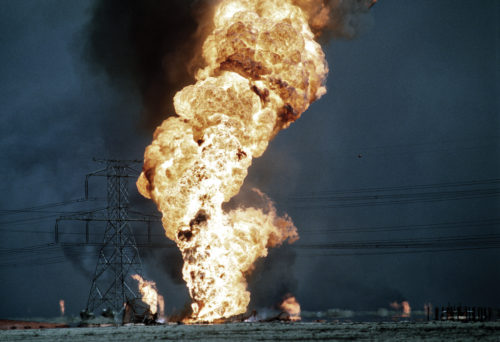
Iraqi President Saddam Hussein declared Kuwait his 19th province, then invaded on Aug. 2, 1990, compromising western oil supply in the process. With his ouster by a UN-sanctioned coalition, the Iraqi dictator ordered hundreds of Kuwaiti oil wells set afire. [Alamy]
The coalition campaign against Saddam Hussein in 1991 was Canada’s first war since Korea
The battle lasted just 43 days. Yet the Gulf War in 1990-91 left indelible images on those who were in it and those who watched it from afar.
As brief and one-sided as it was, the coalition campaign to drive Saddam Hussein’s Iraqi forces out of occupied Kuwait was elevated in the public eye by non-stop coverage on the world’s first all-news channel, CNN.
The fighting began Jan. 17, 1991, with CNN’s exclusive reporting from the Al-Rashid Hotel as the first bombs fell on Baghdad, the pictureless rumble of explosions and breathless commentary giving it an old-time radio quality reminiscent of Matthew Halton, Peter Stursberg and Edward R. Murrow a half-century before. The first pictures of the night sky lit up over Baghdad were awe-inspiring.
Over a remarkably short time, CNN’s Bernard Shaw and Peter Arnett, not to mention NBC’s “Scud Stud,” Canadian Arthur Kent, became household names alongside those of the main characters, Colin Powell (chair of the U.S. Joint Chiefs of Staff at the time) and coalition commander Norman Schwarzkopf Jr., along with Saddam’s henchman, Tariq Aziz.
Saddam himself was depicted as a kind of comic-book villain, a ruthless madman known by his first name who had unleashed chemical weapons on his own people, declared oil-rich Kuwait the 19th province of Iraq, and invaded on Aug. 2, 1990.
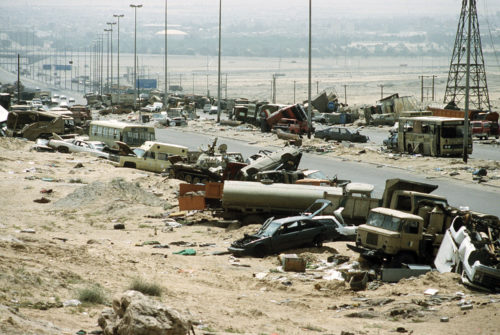
Demolished vehicles line Highway 80, forever known as the Highway of Death. It was the main route of escape taken by fleeing Iraqi forces as they retreated with stolen booty from Kuwait during Operation Desert Storm. Coalition aircraft wrought apocalyptic destruction upon the columns, bringing Saddam’s war to an ignominious end. [TSgt. Joe Coleman/U.S. Military]
The buildup of coalition forces and enforcement of sanctions and blockades, known as Operation Desert Shield, began soon after. When that failed to move Saddam to withdraw his forces from Kuwait, Operation Desert Storm, a brief and violent coalition offensive, ensued.
The conflict took on a video-game quality as networks broadcast onboard video of so-called “smart” bombs and cruise missiles closing on their targets, the black-and-white pictures turning to electronic snow as the projectiles struck, the wow factor ultimately tempered by Iraqi documentation of civilian death and destruction. It was sobering evidence of war’s inevitable “collateral” damage, technology notwithstanding.
The Gulf War gave us confounding images of a venerable Second World War battleship, USS Missouri, launching high-tech Tomahawk cruise missiles at the Iraqi capital, more than 530 kilometres away.

Crew man a 40mm Bofors cannon aboard HMCS Protecteur during workups en route to the Persian Gulf. The weapons were hand-me-downs from the former aircraft carrier Bonaventure. Contrary to its name, Protecteur, a supply ship, was unarmed before the Gulf War. [Dan Myers]
The world watched as sirens wailed across Israel and the Middle East while civilians and military donned gas masks, some in hazmat suits, and scurried into shelters under a rain of Scud missiles. As it turned out, they were not chemically armed but, like the buzz bombs and V-1 rockets of the Second World War, they wrought their share of random death and destruction.
The five-week air campaign was like a turkey shoot. Burned-out vehicles loaded with booty and the charred remains of Iraqi troops were strewn along what became known as the Highway of Death, forming some of the most graphic images since the Vietnam War and triggering newsroom debates around the world over what the purveyors of fact should and should not run in this new age of 24-hour news and information. The immediacy of the new technology posed challenges to journalism’s decision-making processes that resonate to this day.
Saddam adopted a scorched-earth policy, torching hundreds of Kuwaiti oil wells as his forces withdrew across the desert. Their roiling flames and black smoke darkened the vast sky, creating an apocalyptic vista while billions of dollars in revenues came down as soot and droplets over thousands of square kilometres—an environmental disaster that stained everything in its path a dirty black.
Oil well fire-fighting specialists with names like Red Adair, Boots and Coots, Wild Well Control and Calgary’s own Safety Boss did in 10 months what experts predicted could take up to five years: put the fires out. The oil-soaked Canadians led the way, extinguishing and capping more wells that any other company: 180 of 600, by some estimates.
The world watched as sirens wailed.
The armies of Kuwait, the United States, Britain, Saudi Arabia, Egypt and France swept in. With as many as 50,000 Iraqis killed, more than 75,000 wounded and 80,000 captured, the ground war launched at 4 a.m. on Feb. 24 ended in just 100 hours, stopping 240 kilometres short of Baghdad and outright conquest.
“Our goal is not the conquest of Iraq,” U.S. president George H.W. Bush had declared at the outset. “It is the liberation of Kuwait.”
The leader of the free world stuck to his guns, and the coalition enacted a ceasefire after suffering 292 killed, 776 wounded and a looming legacy known as Gulf War Syndrome, typified by a still-unexplained set of acute and chronic symptoms, including fatigue, muscle pain, cognitive issues, insomnia and rashes.
The decision not to unseat Saddam set the table for a repeat—the far more protracted, costly and controversial Iraq War—12 years later. It fell upon H.W.’s son, George W. Bush, to finish the job.
With Saddam facing the gallows and legions of jihadists waiting in the wings, Dubya’s words “Mission Accomplished” would come to stand among the more mistaken assumptions any president ever uttered.
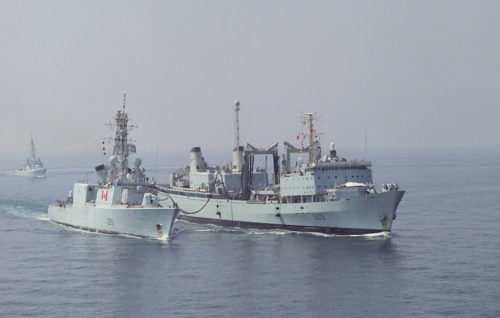
Supply ship HMCS Protecteur refuels HMCS Athabaskan, one of the two Canadian destroyers dispatched to the Persian Gulf. [DND]
For Canada’s military, the 1991 United Nations-sanctioned conflict was its first war since Korea. It was also the first war in which Canadian women were placed in combat roles.
More than 5,100 army, navy and air force personnel were deployed at sea and in the desert but, to many Canadians, their contributions are largely unknown and sacrifices unrecognized. No Canadian was lost to enemy action in the Gulf War.
Three Canadian ships—the supply vessel HMCS Protecteur along with the modified and upgraded destroyers HMCS Athabaskan and HMCS Terra Nova—were first to go, setting sail from Halifax Harbour on Aug. 24, 1990, 22 days after Iraq invaded Kuwait.
Cheered on by waving crowds lining the harbour and aboard small pleasure craft, they steamed out of the historic port. “Down the drain with Saddam Hussein,” declared one banner.
“We didn’t know anything,” said Harold Davis, an air weapons systems technician aboard Athabaskan. “We didn’t know what was going to happen. We didn’t know if we were going to come back. I’m sure that played in the back of everybody’s mind.”
The ships were outfitted with Phalanx close-in weapons systems, six Bofors 40-millimetre anti-aircraft guns apiece, chaff systems and updated electronics and communications suites. And specially equipped Sea King helicopters.

Canadian ground crew bolt down the steel tarmac in Doha, Qatar, with U.S. Marine Harrier jet in the background. Ground crew were the unsung heroes of Canada’s war in the Gulf, working tirelessly to keep the planes flying. [DND]
The aged and much-maligned Sea Kings had inherently more endurance than most of the fleet’s other helicopters. Their forward-looking infrared sensors gave them the much-valued capability to detect smaller vessels at night. Plus the Canadians could communicate securely with and be a conduit between all Allied forces in the Persian Gulf.
All three vessels arrived in Bahrain on Sept. 27 and immediately started enforcing the embargo. They conducted 100 interdictions and hailings in the first week alone. By the start of offensive operations in mid-January, the Canadian ships—just 10 per cent of the coalition’s seagoing force—had conducted more than a quarter of all interdictions (1,644 of 6,103).
Protecteur did double-duty, refuelling the fleet at sea even as it mounted armed boarding parties against vessels trying to run the gauntlet.
The Canadians also operated a field hospital at Al Qaysumah, Qatar, had a joint headquarters in Manama, Bahrain, and mounted a formidable air force contingent based in Doha, Qatar.
“It was like 10 o’clock at night because of all the oil fires.”
Twenty-six CF-18 fighter-bombers and 40 pilots from two squadrons, backed by 300 support crew, saw more combat flying than any Canadian military aviation contingent in 40 years. They were known as the Desert Cats, and they flew constantly, around the clock, shared in the destruction of an Iraqi patrol boat, and conducted 56 bombing sorties against Iraqi forces.
A company of the Royal Canadian Regiment from Garrison Petawawa provided security and guarded prisoners, while about 40 Canadian sailors, soldiers and air force personnel served on routine exchange with various allied forces.
The experience gained before, during and after those few months informed Canadian military leadership, senior enlisted personnel and the rank-and-file in ways that helped see them through a difficult era of disaster relief and post-Cold War peacekeeping.
It was an era tainted by scandal and bruised by public indifference that ended only with the terrorist attacks of 9/11 and the onset of a new age distinguished by the sacrifices of 158 Canadian military lives in Afghanistan.
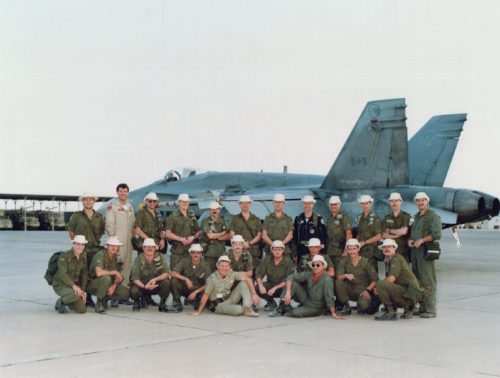
RCAF personnel pose alongside a CF-18 in Doha during Operation Desert Storm. Canadian hatmaker Alex Tilley scored a marketing and public relations coup when he won a contract to outfit the Canadian contingent with his signature headwear. [Jake Wierenga]
“Everybody’s war is different,” said Davis of the Canadians who were so widely dispersed in 1990-91.
A master corporal in the air force at the time, Davis served 32 years in all, much of it at sea. He is now president of the Persian Gulf Veterans of Canada, an advocacy group. He served aboard Athabaskan and was part of the CFB Shearwater team that retrofitted the Sea Kings for embargo and wartime duties.
They made 130 modifications to the helicopters in 14 days, swapping out some equipment and installing night-vision suites, infrared sensors, GPS receivers, flare dispensers to ward off heat-seeking missiles, and a door gun, all while maintaining the delicate balance of weight and distribution.
“I’ve never seen morale on a ship so high,” said the native Newfoundlander, who didn’t see his wife Lynn for almost a year after he departed Halifax. “We had a goal in mind of what we were doing and nobody was going to stop us from doing it. We could take a square peg and stuff it into a round hole if that was the order.”
The Canadians became a go-to contingent, disproportionately executing the unenviable job of boarding foreign cargo vessels. If the Americans didn’t have Marines onboard, they weren’t boarding blockade runners, said Davis.
The Canadians had no such restrictions. Ships’ companies were trained to do the dirty work, suiting up and arming themselves, taking pounding rides aboard Zodiac fast boats, deploying rope ladders and climbing up the sides of massive oil tankers at sea, some several football fields long, with little to no idea of what awaited them when they reached the deck.
Most of the cargo ships were destined for Iran. They were turned back and escorted to a holding area where they laid at anchor for months. Some refused to stop and had to be chased down.

Medic Robert Harley ferried a lone ambulance from Bahrain to the Canadian embassy in Kuwait City. He gave Kuwaiti children bottles of water as Canadian troops secured the building, raised the Maple Leaf, and refilled its rooftop cisterns. [Robert Harley]
When the guided-missile cruiser USS Princeton hit two sea mines and broke its back, Athabaskan raced to the rescue. The bridge kept a close eye on the ship’s mine-avoiding sonar as they delivered damage-control supplies and escorted an ocean-going tug in to pull the disabled American vessel to safety.
Princeton was dead in the water in the middle of a minefield for 31 hours with two wounded aboard. Its captain, Edward Hontz, specifically requested Athabaskan, which was patrolling another area. The Canadians sailed right through the treacherous waters.
“We were going under five knots,” said Davis. “I never slept below the waterline during that time. I slept up in the hangar on the floor. A lot of guys spent a lot of time on the upper decks.”
Crew were stationed all over the ship keeping an eye out.
Athabaskan deployed a Sea King to ensure the area was clear of mines before the tug made its run to the big ship to hook up a tow rope. The Canucks also winched over several two-fours of good Canadian beer to the dry American ship, enough for everyone aboard.
RCAF Captain David Deere had just finished the Top Gun Canada course—officially the Fighter Weapons Instructor Course—when he transferred from Norad defence duties with 441 Squadron in Comox, B.C., to 416 Squadron in Cold Lake, Alta. For a fighter pilot, his timing couldn’t have been better.
“I was confident in my ability to be able to meet any mandate required as we went off to the Middle East to do this for real,” he said.
A 10-year air force veteran, he was among the 40 pilots from 416 and the Baden, Germany-based 439 Squadron to form the Desert Cats, a derivative of their respective nicknames, Lynx and (Sabre-Toothed) Tigers.
With pilots already flying patrols in Operation Desert Shield, the newly formed group assembled in Baden to work up for the job ahead. They arrived in Doha about mid-November.
Shortly after 2:30 a.m. on Jan. 17, U.S. helicopters blasted Iraqi radar sites that would warn of an impending air strike, opening a narrow corridor along the Saudi border through which the coalition could fly. The choppers had no sooner done their work when their pilots reported a flood of coalition jets pouring thru the gap.
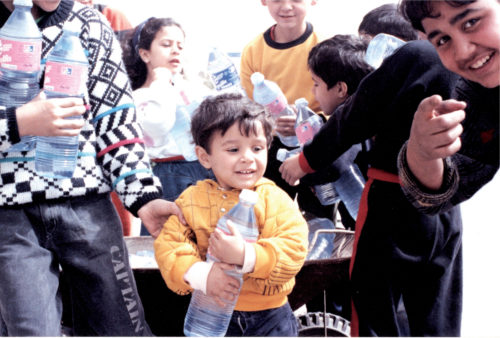
[Robert Harley]
Soon the skies over Baghdad were lighting up with cruise-missile strikes launched from U.S. Navy ships in the Persian Gulf and aircraft attacks on surrounding radar and anti-aircraft sites. These were followed by massive strikes on bunkers, missile launch sites, communications and radio facilities, storage areas and airfields.
Coalition aircraft flew 2,775 sorties in the first 24 hours. Iraqi air-defence systems, installed by the Russian military, were ineffectual. In more than 100,000 sorties, just 75 coalition aircraft were lost overall. Only 42 were shot down; 33 went down to accidents.
With Iraqi orders flowing out of Saddam’s headquarters, the coalition began the systematic elimination of command-and-control facilities.
The Canadians were propelled into combat with the first strikes. At the base in Doha, ground crews started a pool on when the first missile would be fired by a Canadian and what type it would be—heat-seeking or radar-guided. The CF-18s carried both, along with three fuel tanks.
They didn’t have to wait long. A Canadian pilot fired a heat-seeker at the smokestack of an Iraqi ship trying to run the blockade. It missed, but somebody at Doha won big.
Deere and his mates were flying combat air patrols, his first sortie launching amid the wail of air-raid sirens warning of an incoming Scud missile. The sirens became a regular occurrence, requiring the entire base to don chemical warfare suits with each warning and spend anywhere from one to four hours in bunkers.
He flew multiple missions over the Gulf each day, protecting “high-value assets”—all manner of warships from across the coalition. Over time, they worked closer to the Iraqi border and eventually into Iraq itself as the ground forces moved north.
Coalition air forces had nearly a four-to-one advantage—2,250 aircraft, 1,800 of which were American, while Iraq had 934 planes, just 550 of them operational. Coalition pilots shot down 38 Iraqi planes in the first week of combat.
Soon, the Canadians were flying sweep escort missions ahead of and behind American and British bombers penetrating deep into Iraq.
“We’d be 10,000 to 15,000 feet above the bomber force,” said Deere.
Three refuelling aircraft, 2,000 to 4,000 feet apart vertically, kept them flying. It was a precision operation in which the fighters pulled up like cars at a gas station every 60-90 minutes. Each plane took its spot at the end of an air-to-air refuelling boom as soon as the one ahead was finished.
Typical missions lasted three to four-and-a-half hours, refuelling just before the assembly point and again on the way back.
“That was one of the most impressive aspects of the Gulf War,” said Deere. “You had multiple missions—inbound, outbound—intercepting these fuel tankers completely radio-silent.
“As we were arriving at one of the tankers, we would see four or eight aircraft departing the tanker just as we were getting there. The co-ordination was remarkable. And nobody said anything—we’d just show up on-time and on-target.”
“I never slept below the waterline during that time.”
Later in the campaign, the Canadians shifted to actual bombing, making the Desert Cats the only coalition squadron to conduct all three assignments—defensive air combat patrols, offensive sweep escorts and bombing missions.
The eight 500-pound all-purpose weapons they carried lacked on-board guidance systems—not so good for hitting specific buildings but eminently workable in stopping retreating columns of trucks, tanks and armoured vehicles. Deere described bombing as “intense.”
They rolled over from 20,000 feet and dropped their loads in a 45-degree high-angle dive, avoiding small-arms fire simply by staying at altitude until they were ready to attack.
Most of the bombing missions were flown during the day, but they saw little of the action on the ground. During night escorts, the pilots couldn’t help but witness the massive fireballs wrought by the lumbering B-52s with their formidable payloads.
“You really, really had to pay attention, do as you’re told and bring in all of the training that you’ve had,” he said. “You’re so focused on what you’re doing, you don’t have time to look at the sights.
“Any fear you may have basically is redirected into doing the damn best job you can because your life depends on it. All of us had our own ways of dealing with it.”
Deere said he wouldn’t have missed it for the world. Now a 737 captain and technical pilot at WestJet, he amassed 3,600 of his 15,000 hours in the air flying military aircraft. “Every pilot deep inside wonders if all the training will be exercised,” he said. “It was pretty exciting, thrilling, concerning.
“The friendships and camaraderie we made during military service is second to none. You don’t often make those kind of deep connections and friendships that you do when you’re actually brothers in arms.”
Robert Harley was a 31-year-old junior medic attached to headquarters when he was summoned from the daily sick parade and other mundane duties to take an ambulance to the Canadian embassy in Kuwait City, passing burned-out tanks and vehicles and bombed-out buildings along the way.
The embassy had been abandoned and then taken over during the occupation. Now that it was liberated, it was expecting a tanker-load of water for its rooftop cisterns. But security concerns called for a workaround: eight truckloads of bottled water, which had to be passed up chain-line by the case, then poured a bottle at a time into the 4,000-litre cisterns.
Troops raised a small Canadian flag over the embassy. A day later, Harley was handed a larger, regulation replacement. He climbed up, took down the small flag and put up the big one. He pocketed the small one.
“Nobody asked for it so I brought it back and gave it to my hometown Legion in Mitchell, Ont. It had oil stains and everything on it.”
The embassy was a mess. It was unclear to Harley whether the Iraqis had occupied it or Kuwaiti forces had used it in the defence of the city.
“Basically, it was war-torn,” he said. “The Canadians pulled out but all the staff were local and stayed behind. They tried to keep it the best they could.
“There was furniture and papers everywhere. It was dusty. There was broken glass. The whole thing was eerie because it was a bright sunny day but it was like 10 o’clock at night because of all the oil fires.”
They carried extra jugs of windshield washer fluid to clear the oil that was raining down. Their clothes were blackened, and there was sporadic gunfire all around them—possibly celebratory.
A worker at the consul-general’s residence took one of the staff vehicles and parked it across the entrance, then blew the tires. He deflated the tires on all the rest of the cars in the underground parking garage to keep them from being stolen.
“He saved the Canadian government hundreds of thousands of dollars,” said Harley.
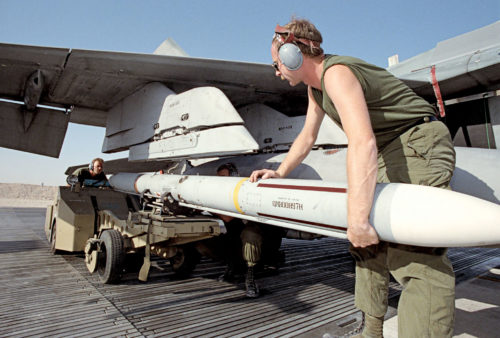
Air force weapons technicians load ordnance aboard a CF-18 in Doha on Dec. 16, 1990. [DND/ISC90-5040]
Medic Darrell Chiasson of the now-defunct Canadian Airborne Regiment served as acting sergeant-major to the first 40 crew to arrive in Al Qaysumah in January 1991. He co-ordinated an advance party to start putting together a field hospital near the Iraqi border.
It took a little more than a week to assemble three operating rooms, a pre-op and a post-op, and an X-ray and laboratory facility—all before the main medical unit arrived.
The unit was functioning at capacity and they had put up most of the canvas for a 500-bed field hospital. Then the war ended.
“Everybody was surprised that it ended as quickly as it did,” said Chiasson, a New Waterford, N.S., native who, at the age of 18, had opted for the military over coal mining. Canadian surgeons were still operating on patients, most of them Iraqi prisoners of war whose bodies were riddled with shrapnel from the unrelenting air strikes.
“When they came in and you did an X-ray on them, they were filled with it.”
Iraqis were “surrendering in droves. They were very timid. You could imagine how very overwhelming it was for them.”
The Canadians’ British neighbours built a PoW camp nearby. It was full.
“They had been bombarded for months,” said Chiasson. “They were defeated. They were being pounded every day. Every morning, around 5:30, the B-52s would fly over. You’d wait and then all of a sudden there’d be a major bombardment. You’d hear it off in the distance. That was every day like clockwork.”
The objective was clear; the mission justified; the goals achieved.
Chiasson described the war as a great learning experience that contributed to the formation of advance surgical teams in Bosnia a few years later and, in 1996, the Disaster Assistance Response Team that would be deployed to disasters the world over.
By the time Canada joined the war in Afghanistan, said Chiasson, it had become adept at mobile medicine and establishing the facilities that went with it.
Roxanne Coutts of Neils Harbour, N.S., didn’t give much thought to her role as one of the first 50 or so Canadian women deployed in combat roles.
In fact, the RCAF master corporal and air weapons systems technician wasn’t even aware of that until after her deployment. She and the few dozen other women made history by serving in-theatre in the sweltering heat of Doha. Coutts was too busy at the time assembling and loading air-to-air missiles aboard CF-18s.
“It didn’t matter,” she said. “We had a job to do and we went and did it. We performed the duties as we were trained to do. The missiles were the same; the environment was different. It never crossed my mind.”
Coutts said she worked with the same crew as she did with 1 Aircraft Maintenance Squadron back in Cold Lake and was treated no differently in-theatre—except for one circumstance. Whenever they took shelter inside an air-raid bunker, which was virtually every day, the men sheltered the women.
“We [women] were pushed in farther and the men would kind of hover over us to make sure we were protected,” she said. “It was just like a male instinct, I guess—a look-after-the-girls kind of thing.”
Nobody took issue with the practice.
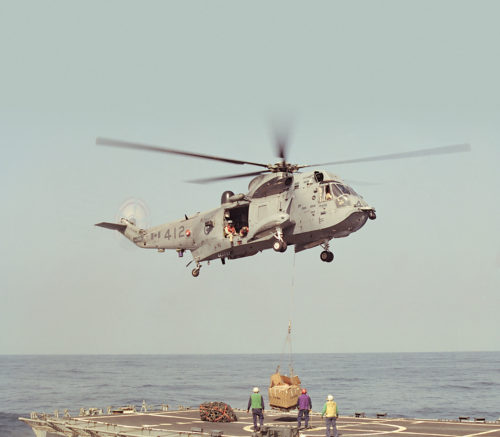
A Sea King helicopter transfers materiel to USS Halyburton. More than 5,100 Canadian Forces personnel deployed to the Gulf War in 1990-91. [ISC91-472A]
Whatever roles they played, Canadians who served in the Gulf War are by and large proud of what they did. The objective was clear; the mission justified; the goals achieved.
Captian Luc Savoie flew in Desert Shield during the Gulf War and, after a stint with Air Canada, in combat in Afghanistan. His closest call came one night when another plane flew about 100 feet directly over him. He assumed it was an uncharted coalition spy plane.
“I don’t know what it was, but I heard it,” he said. “I wasn’t very happy about that. He came in from the side, left to right, as we were turning around. We never saw it coming, never picked it up on radar. That pissed me off, but it was war. That’s the way it goes. Other than that, it was pretty dull, I gotta tell you.”
Based in Germany at the time, Savoie said securing the oil supply had everything to do with the response to Saddam’s aggression.
“If it was a piece of land with nothing around it, I don’t think we’d be going there,” he said. “Because it was strategically important for the Americans and the Western world, we did. If Saddam was allowed to go unchecked, where would he have gone next? Saudi Arabia?”
Savoie understands why Canada supported the mission and was pleased it had UN backing. He further thinks Prime Minister Jean Chrétien made the right decision when he turned down George W. Bush’s request to participate in the unsanctioned Iraq War. By then, the younger Bush was “itching for a fight,” one that opened a Pandora’s Box in the region.
The Gulf War had another positive outcome for the Canadian military, which had long carried the mantle of peacekeeping.
“It was finally recognition from the people that, ‘hey, this military is not only for peace; it’s also for war,’” said Savoie.
Advertisement


















